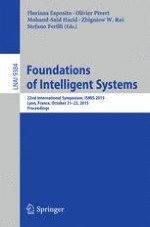2015 | Buch
Foundations of Intelligent Systems
22nd International Symposium, ISMIS 2015, Lyon, France, October 21-23, 2015, Proceedings
herausgegeben von: Floriana Esposito, Olivier Pivert, Mohand-Said Hacid, Zbigniew W. Rás, Stefano Ferilli
Verlag: Springer International Publishing
Buchreihe : Lecture Notes in Computer Science
